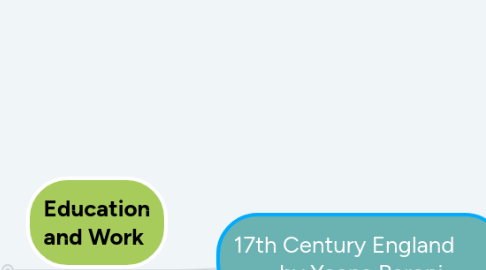
1. Economy
1.1. Trade and commerce grew.
1.2. Industries (glass, brick making, iron and coal mining) expanded.
1.3. In 1694 the Bank of England was founded.
1.3.1. Before people used to deposit money with goldsmiths.
1.4. At the top of the society were the nobility, then the gentry, below them were the yeomen and at the bottom the mass of the population, craftsmen, tenant farmers and laborers.
1.4.1. The goldsmiths gave receipts (notes) for the gold promising to pay on demand.
1.4.1.1. Merchants and tradesmen began to exchange the notes as a form of money.
2. Society
2.1. The rich
2.1.1. A piped water supply was created.
2.1.1.1. and you had to pay if you wanted to be connected to the supply.
2.1.2. A horse drawn carriage (hackney carriage) could be hired to go around London.
2.1.3. The architect Inigo Jones designed the Banqueting Hall in Whitehall.
2.1.4. Oil lamps were hung outside every tenth house.
2.1.5. The bookcase and armchairs appeared.
2.1.5.1. Furniture like chests of drawers and grandfather clocks became popular.
2.1.6. Were introduced new foods (bananas and pineapples) and drinks (chocolate, tea and coffee).
2.1.6.1. There were many coffe houses in the towns, professional men met there to read newspapers and talk shop.
2.1.7. Turnpike roads opened.
2.1.7.1. You had to pay to use them.
2.2. The poor
2.2.1. People began to build their homes in stone or brick.
2.2.2. Chimneys and glass windows became more common.
2.2.3. The food remained plain (bread, cheese, onions and pottage) and if they could afford it pieces of meat or fish.
2.3. Pastimes
2.3.1. cards, bowls, tennis, shuttlecock, chess, drafts, backgamon and fox and goose.
2.3.1.1. The wealthy played pale-maille. The theater was popular and boy's play women's parts. Yachting was a popular sport.
2.3.1.2. The poor we had cock fighting and bull or bear baiting.
3. Education and Work
3.1. The rich
3.1.1. Both boys and girls went to petty school.
3.1.2. Only boys went to grammar school.
3.1.2.1. They would work from 6am to 5.30pm, with breaks for meals.
3.1.2.2. Corporal punishment was usual.
3.1.3. Girls were taugh by tutors.
3.1.3.1. Boarding shcools were founded.
3.1.3.1.1. In them girls were taugh subjects like writing, music and needlework.
3.2. The poor
3.2.1. Girls were taught by their mothers.
3.2.1.1. There were several jobs women could do, like spinning cloth, millines, dryers, shoemakers, embroiderers, washerwomen, brewers, bakers, confectioners, doestics servants, midwives and apothecaries.
3.2.1.1.1. Most women were housewives and were kept very busy, because they themselves would run the household. And were supposed to have some knowledge about medicine.
4. Rulers
4.1. Charles I (1625-1649)
4.1.1. Was executed after the Civil War that began in 1642.
4.2. Oliver Cromwell, Lord Prtotector (1653-1658)
4.2.1. He is seen as a dictator and a tyrant.
4.3. Charles II (1660-1685)
4.3.1. Parliament dediced to restore the monarchy, and invited him to return to England.
4.3.1.1. During his reing we can name two important events: The Great Plague (1665) and The Great Fire of London (1666)
4.3.1.1.1. When he died, he left no legitimate chikdren to inherit the thone.
4.4. William III of Orange and Mary II, jointly (1689- 1694) William III of Orange (1694-1702)
4.4.1. They began their reign in 1689, but before they signed the Bill of Rights.
4.4.1.1. The power was balanced between Parliament and the monarchy,
4.4.2. Parliament passed the Bill of Rights in 1689, which was the first step towards a contitutional monarchy.
4.5. James II (1685-1688)
4.5.1. He was a Catholic and wanted the same of his subjects.
4.5.1.1. When his son was was born in 1688 and he announced that he would be raised Catholic his fall began.
4.5.1.1.1. The Glorious Revolution (1688)
